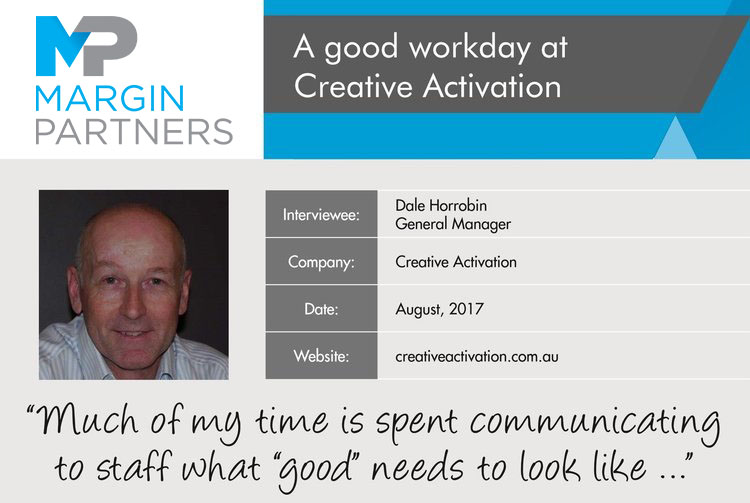Context:
In the Jan-Feb 2010 edition of the Harvard Business Review, authors T.M. Amabile & S.J. Kramer provided ground breaking research findings into what produces a “good day” in the workplace. Within some 12,000 individual diary entries, “progress” or the sense of ‘moving the dial’, was the vital ingredient discovered in over 76% of participants “best days” at work.
Margin Partners interviews Australian Leaders to benchmark the regularity of “good workday’s” and to provide insights into how they’re frequency can be increased.
1. Describe a good work day for yourself:
I’m about outcomes. I seek result confirmation through verbal and numeric means. A good day takes shape when I feel that my business strategy is being refined or implemented. The sense of progress drives me. Equally, the feeling of validation from either staff or clients, that my contribution is adding value to their role or needs. Moving up the satisfaction scale would be notification that confirms a new business has been secured. Such wins mean that a client trusts us. From a financial perspective, we need to achieve budgets. It’s a given. However, a good day will see a step change from a staff perspective where someone identifies a cost inefficiency. One recent initiative by a team member resulted in material saving of more than $20k. I had to take the team out for dinner to celebrate. Much of my time is spent communicating to staff what “good” needs to look like.
2. Describe a goodday for your companies P&L:
Firstly, it’s confirmation that the profit target has been exceed for the month; quarter or ideally the year. Secondly, it’s about new business, which is vital because it mitigates the ongoing risk of a client loss. The process required to gain new business is demanding on people and financial resources, but this is understood and factored in. Frankly, any new business win makes a day “great”.
3.Do the two days align?
Very much so. I know what I need the business to do and my feelings of satisfaction are tied to things that directly contribute to the profitability of the organization brand integrity is upheld for tomorrow.
4. Where is value chain leakage most likely to occur in your sector?
With a large call center and field sales force, it’s in lower than expected productivity. Metric’s are a vital tool for aligning individual performance to business expectations. Beyond this sits discretionary spend. Routinely I have found that this can blow out if staff fail to join the dots between customer service and productivity. The relationship between their role and the P&L is something I constantly seek to bring to light. My final item would be misunderstanding of customer centricity. I believe we too often fail to charge customers for some or all the very valuable additional service we provide, and I don’t know why.
5. Key Takeout:
Dale felt that identifying leakage within the business should be a basic competency for his people. However, it isn’t always so, especially if they don’t realize that whilst achieving “50 outbound calls a day constitutes “good”, it’s actually “bad” if additionally contract labour is needed to compensate for lower than expected productivity of core staff”. Furthermore, the perspective of the “P&L” is that people will simply deliver the agreed margin. Hence, its attention is on securing new business to maintain long term viability and risk reduction. The interview affirmed that the salient presence of any of the big 3 inefficiencies (behaviour, knowledge & process) necessitate governance via role clarity and performance measurement. Scorecards or KPI’s that drive alignment with the P&L will make for a good day. Great days can then be pursued.



